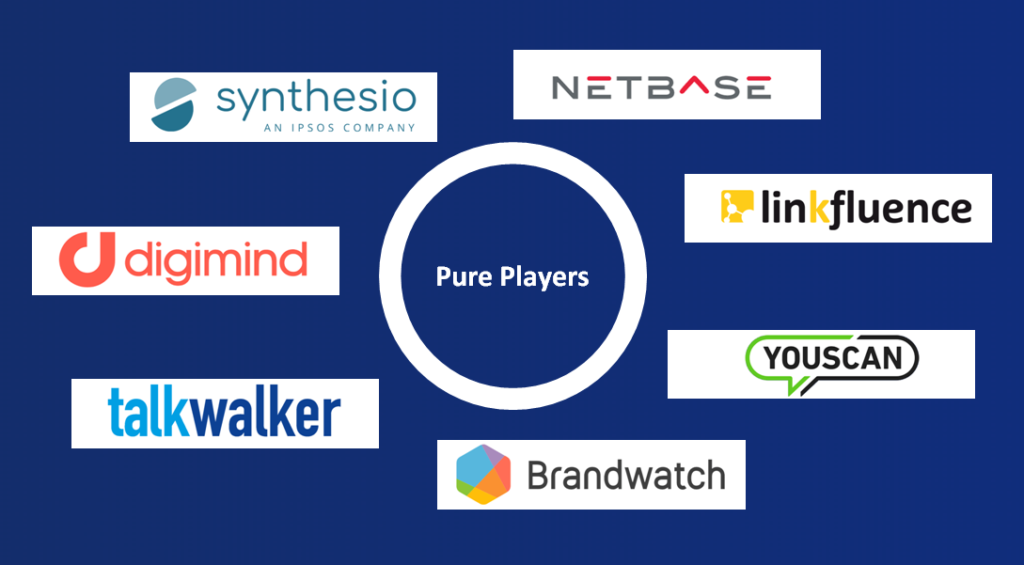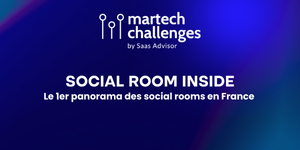Social Listening is an important part of any social media strategy, but it is a big topic! There are countless software solutions dedicated specifically to Social Listening, and there is a good chance your company’s marketing stack has one. That is why we want to break down the basics of Social Listening down, to make sure you know exactly what it is and why it is important.
Today we will answer the following questions:
- What is Social Listening?
- Why opt for a Social Listening strategy?
- How to choose the right tool?
- What are the some of the most popular and reputable solutions?
- Where can you find a Social Listening consultant?
- Where can you find Social Listening training?
What is Social Listening?
Social Listening refers to the monitoring and analysis of your company’s social media for any trends happening not just around your brand, but around your industry as a whole, and using those insights to make better marketing decisions.
Social Listening allows you to monitor your social media channels for any customer feedback and interactions with your company regarding specific topics, competitors, or industries. On a broader scale, social listening allows you to be up to date with your entire industry, what is happening and why, and interact directly with not only your current customers but potential ones as well.
It is a very analytical process that allows you to gain insights on your audience to find the best opportunities for your business.
According to SproutSocial, there are 5 key use cases for Social Listening:
- Brand health: Gauging the public perception of your brand or products.
- Industry insights: Analyzing discussions or hashtags within an industry.
- Competitive analysis: Analyze a competing brand or product.
- Campaign analysis: Report on how a campaign is resonating.
- Event monitoring: Monitor audience response to a conference or event.
Social Listening helps you understand the reasons behind conversations that are happening about your company, your customers, and your industry. This can help you gain insight into how to improve your future campaigns, content, messaging, etc., as well as provide effective benchmarking with your competitors.
At Saas Advisor, we are very familiar with the Social Listening world. In 2019, we launched the first ever Martech Challenges that evaluated the best Social Listening SaaS tools on the market in their respective categories according to a very precise list of criteria. The competition was conducted in real-life conditions, based on real briefs, and judged by a panel of professional jurors. If you are curious to learn more about the challenge and want to know the results, you can download the full report.

Why Opt for a Social Listening Strategy?
Social Listening has been adopted by a huge number of companies and brands because it helps them tackle a number of important challenges like managing crises, benchmarking, engaging with customers, and more. Using this type of strategy allows your company to react quickly and be in the know with what is going on in your industry. It is an effective strategy, but it must be implemented correctly and with the right tools.
We have broken down some of the key benefits to opting for a Social Listening strategy to give you the information you need to decide if it’s time to create your own.
- Engage with customers: One of the biggest opportunities Social Listening gives your company is the chance to engage with your customers. By monitoring all mentions and interactions your audience has with you on social media, you are able to directly respond and engage with them. Examples of this can include a customer who may have tweeted about how much they loved your product, or a customer who sent you a direct message on Instagram for a customer service issue. No matter the situation, customers want to feel like they are being heard on social media. According to SproutSocial, 83% of respondents like when brands respond to questions, and 68% like when brands join conversations. This shows that it is very important for brands to respond and engage with their customers to encourage customer loyalty and satisfaction.
- Benchmark your competition: Not only does Social Listening allow you to see what your customers are saying about you, but about your competitors as well. Knowing what your customers and audience are saying and hearing about your competition allows you to see where you fit in the marketplace and helps you benchmark effectively. By following your competition on a Social Listening tool, you can see what they are doing in real-time. New campaigns, products, and potential crises are all examples of things you will be able to identify quickly. This allows for you to respond when appropriate and identify possible opportunities.
- Manage crises: Social Listening allows you to address any negative incidents or PR drama before it gets out of hand. If you are faced with a crisis, Social Listening tools can help you manage them quickly and effectively. By analyzing the incident, you can dive into the issue to see if it has led to a decrease in followers, sales, etc. which will allow you to determine if serious action must be taken or if it is a manageable issue. Because Social Listening allows you to measure sentiment, and when that sentiment is negative, you can see exactly where it originated (a tweet, instagram post, etc) and address the issue right away. A Social Listening tool will alert you when this type of event occurs so you can analyze and manage it quickly.
- Discover potential new customers: Understanding what is going on in your industry will allow you to identify any pain points or issues relevant to your company. For example, if you see that someone is struggling with a relevant issue, you can reach out, make a connection, and share helpful information. This will help establish your brand as a reliable resource when it comes time to buy. Nurturing these relationships can turn them into new customers and advocates for your brand. You may also see where your competitors’ customers are having issues with them, and where appropriate, you may cut in to offer your alternative.
- Find industry influencers and create an advocacy plan: Monitoring your industry will give you an idea of who and where influencers in your industry are. Knowing this will allow you to connect with the right people to boost your influencer marketing strategy. Additionally, you can implement an advocacy plan. This means you have a strategy in place to reach out to and reward your company’s advocates. By listening to your customers and their sentiment for your brand, you will be able to identify the people that love and advocate for your brand on social media.
How to Choose the Right Tool?
So, you may now be wondering how to choose the best tool to get the most out of Social Listening. Every organization is different, has different needs and challenges, and therefore the choice of tool will vary. However, there are a few key steps and characteristics to look for when you are choosing your Social Listening tool.
- Step 1: Do a needs analysis. Sit down and take a look at what your exact needs are and how your organization is going to use the tool. Which departments will be using it? How will they be using it? What are the most important features for our company? Answering these questions will give you a clearer picture of what you need and which tool may fit best.
- Step 2: Set your objectives. Different companies have different objectives. For example, maybe you are most interested in finding influencers for your brand, your tool may be different than someone who’s main objective is to manage negative sentiment.
- Step 3: Determine your budget. The pricing model of tools varies, and can depend on things like the amount of users, dashboards, social media accounts, and more. It is important to know how you are going to use the tool so you can determine an accurate budget. Once you have this information, it will be easier to choose a tool that fits your price range.
Characteristics to look for:
- Reporting: Reporting is an important feature to have because it will allow you to monitor your progress as well as give you crucial information to determine your ROI.
- Sentiment: Sentiment analysis breaks down your mentions and interactions into positive, negative, and neutral to give you a clear picture of overall brand health and pain points. It can also show you how these sentiments change over time.
- Demographics: Your tool should give you a breakdown of the demographics (age, gender, location, etc) of who is talking about you on social media to allow for more effective targeting and analysis.
- Insights: Insights are important because they identify any significant changes and allow you to determine if something needs attention. It can also help you identify new opportunities to communicate.
An example of a dashboard may look like this:

Notice the sentiment, demographics, and other information available to the user.
What are Some of the Most Popular and Reputable Solutions?
Here is a list of some great Social Listening solutions:
Agorapulse: Is a highly-professional platform that boasts a clean, straightforward interface and clients worldwide. They have powerful parameters to let you pinpoint exactly what you are looking for.
Bloom: Bloom is a highly technical Social Listening solution based in France. They take an insight-centric approach to Social Listening and have their own technology called Social and Semantic Inference, which is their “radical new take on traditional social listening.”
Brand24: Brand24 is an accessible platform that targets businesses of all sizes. Some of their top features are their Influencer Score which helps pinpoint industry influencers and the Discussion Volume Chart that graphically depicts your brand’s mentions.
Brandwatch: A contestant in the Martech Challenges in 2019, Brandwatch is a very popular and effective platform. When the results of the challenges were released, they won best in class in queries architecture, settings, governance, and personalization.
Digimind: Another one of our contestants, Digimind is a French company whose mission is to “help their customers understand the world as it is.” They were voted best in class in workflow, partnerships, and integration.
Linkfluence: Another one of our Martech Challenges contestants, Linkfluence is an industry leader in the Social Listening sphere. They won best-in-class in four categories: Influencer analysis, performance, setup and onboarding, and earned / owned media.
Meltwater: Meltwater focuses on analytics and focused engagement, and backs it up with AI-driven insights. It examines posts from all over the internet, not just social media, and filters out irrelevant mentions and assigns sentiment to the mentions that interest you.
Pulsar: Pulsar is a Social Listening platform that believes in the power of audience intelligence, and has it engrained in its technology. This allows its users to get insights on their audience beyond social media and has a number of owned-media listening tools.
Quintly: Quintly is a heavy hitter when it comes to in-depth analysis. Their dashboards are designed to uncover insights and optimize your professional social media strategy.
Sprinklr Modern Engagement: Sprinklr Modern Engagement is one module of the greater Sprinklr Platform. The complex dashboards allow you to see the details (context, sentiment) of relevant conversations happening in real-time as well as historically to give you the information needed to make the best decisions to support your goals.
Synthesio: Sythensio participated in the Martech Challenges and were determined best-in-class in special and AI based features as well as non-listening capabilities. Synthesio has hundreds of customers, mostly large global brands across all industries.
Talkwalker: Talkwalker is another one of the Martech Challenges contestants.They provide companies with an easy-to-use platform, powered by AI, to protect, measure and promote their brands worldwide across all communication channels. They won best in class in the following categories: tagging, reporting, usability, and pre-built modules
Youscan: Our last Martech Challenges contestant on this list, Youscan is a powerful Social Listening platform whose visual analysis capabilities are best-in-class.
Where Can You Find a Social Listening Consultant?
When it comes to Social Listening, personalization is key. You need to find a consultant that understands your specific needs and challenges, as well as a precise knowledge of the technology and solutions. At Saas Advisor, the Social Listening landscape is one of our specialties. We are very familiar with many platforms and have worked with them many times, so we know which type of solution works best for certain challenges, industries, and so on. We consult with major groups on their Social Listening tools, dashboards, and strategies. If you are looking for an attentive, knowledgeable consultant, do not hesitate to reach out to us.
Where Can You Find Social Listening Training?
As a part of our offer at Saas Advisor, we offer personalized training to your company on the tools you have adopted. This helps you ensure that the use of your tool is standardized, optimized and perpetuated.
If you already have a tool in place and are just looking to brush up on your knowledge, many solutions provide “academies” where you can take online courses to improve your knowledge and use of your tool. Sprinklr, for example, offers this type of training. You can turn to platforms such as LinkedIn or Hubspot Academy to get further training in the world of social listening.
Want to read on?
Check out our guide to the martech landscape!
Have any thoughts on these tools, or any questions you would like to ask us?





